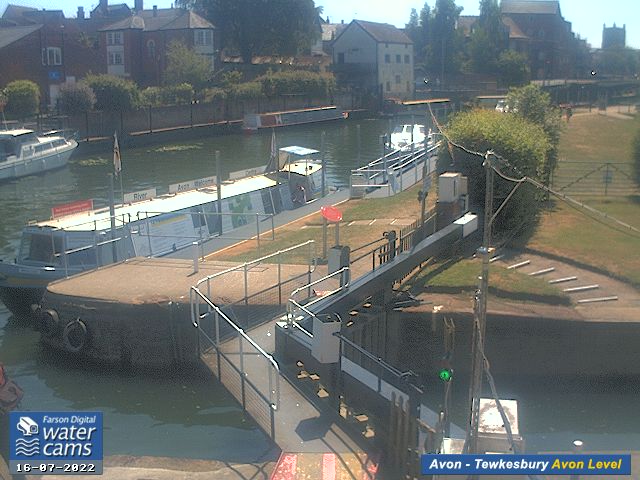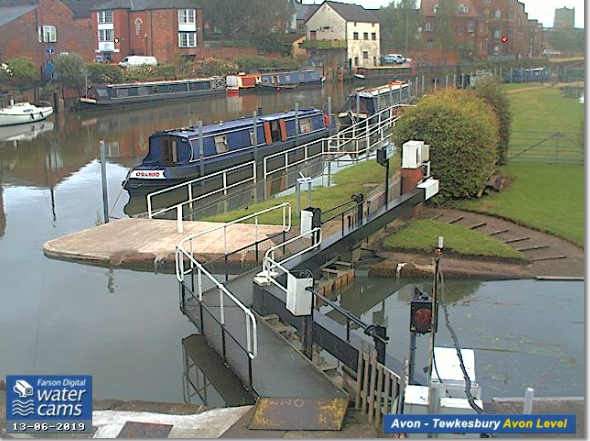
By Royal Charter of 1636, a rare example of a lock that is still a toll station between two separate river navigations - the Avon and the Severn.
Avon Lock,
King John`s Court,
Tewkesbury
Avon Lock, owned and maintained by the Avon Navigation Trust (Registered Charity No. 244951) is located in the center of Tewkesbury; a Cotswold Market Town known for its history and heritage tourism. The Lock itself receives 1000's of visitors each year from leisure and commercial boaters, school groups, locals and tourists all interested to see industrial transport history still in use today.
It forms the junction between the Warwickshire Avon and the River Severn and is rare because it is at, not only a confluence of two rivers, but at a confluence of two navigation authorities. The River Avon remains one of only a handful of UK waterways still independently owned and it's been that way since King Charles I granted a charter to a private individual. Avon Lock was a toll station then and it remains one today.
The site is easily accessible by boat and on foot. It features as part of Tewkesbury's Riverside Walk, a new initiative guiding visitors around local attractions providing interpretation boards at key sites. The recently restored Village Green adjacent to Avon Lock is now a popular picnic site. For those who wish to "visit" the Lock from thecomfort of their own homes we have two, live feed webcams available to view as part of The Avon Navigation Trust's Riverwatch scheme.
Webcam image on 16 July 2022 showing the Red Wheel plaque on a pedestal beyond the lock gate. Also shows the re-launched ANT visitor centre on the barge William James moored alongside the heritage plaque:

Example of the webcam view with very high water level in 2019:

There has been a lock on this site since the charter was granted in 1635, then followed a huge engineering project to install weirs, locks and river gates to develop the previously unnavigable river into a commercial transport enterprise.
Avon Lock is the gateway, flagship structure completing the trade route linking Warwickshire, Worcestershire and Gloucestershire with the River Severn to the Sharpness Docks and the sea. It still operates as a toll station nearly 400 years on.
In 1830 the river was leased to the Worcester & Birmingham Canal Company but the opening of rail links locally saw profits begin to fall with commercial transportation moving to the railways until the income was too small to cover the cost of engineering repairs and maintenance on the river. By 1930 the route was abandoned by all but one cargo vessel, the grain barge Pisgah, which continued to operate from Pershore Mill until 1972.
This entry by former lock keeper Nicola Lancaster.
Unveiling update:
Cancelled twice because of floods and then kiboshed by Covid, the Lord Lieutenant of Gloucestershire, Edward Gillespie OBE, unveiled National Transport Trust’s Red Wheel plaque during Tewkesbury’s water-borne BIG Weekend 21-22 May 2022 - a heritage honour conferred way back in 2019. The VIP party included Vice President of National Transport Trust and Patron of Avon Navigation Trust -Tony Hales CBE, Avon Navigation Trust Chief Executive -Clive Matthews, Tewkesbury Town Mayor - Cllr Simon Raywood, Chairman - Jack Hegarty, Director - Roger Clay, Deputy - Chairman - Michael Hodges and Volunteer and BIG Weekend Riverside Organiser - Paul Cronin.
HISTORY OF THE AVON NAVIGATION
In 1636 the history of navigation on the Avon commenced when letters patent were granted by Charles the First to William Sandys of Fladbury who used his private fortune, estimated between £20,000 and £40,000, in purchasing the necessary land and property and in the construction of sluices, weirs, channels and locks to make the Avon navigable from Tewkesbury to Stratford.
In 1758 the Lower Avon (ie the 26 miles/42 km fromTewkesbury to Evesham) was acquired by George Perrott who discovered that the locks were in such poor condition that in places passage was impossible, and it became necessary to close the Navigation for some months while repairs were carried out. Over a period of ten years some £4,000 had to be spent in restoration.
In 1830 the Lower Avon was leased to the Worcester and Birmingham (Canal) Company for £1,000 per annum for 21 years, during which period they spent considerable sums on repairs. On expiry the lease was renewed but a lower rental was negotiated as the profits of operation had fallen steadily throughout the first term, and when the railway linking Evesham to Gloucester was opened the Lower Avon commenced making substantial losses each year and consequently the lease was terminated finally in 1872.
The declining standard led to the formation in 1899 of the River Avon Improvement Association, which successfully persuaded the Local Authorities in 1903 to call a public enquiry into the state of the navigation, but unfortunately the Commissioners' recommendations, which would have led to restoration, were not accepted. By 1914 the income from the Navigation was insufficient to carry out proper maintenance and the traffic operators, together with mill owners and Local Councils, were obliged to undertake essential repairs at their own expense.
In 1919 local borough and county councils became concerned about the condition of the Avon, and setup a joint committee to draw up a scheme for restoring the whole river for submission to the Ministry of Transport. The cost was claimed to be prohibitive, and the scheme was dropped.
In 1924, The Lower Avon Navigation Company Ltd was formed and acquired the Navigation by purchasing the Perrott interest. Over £2,000 had to be spent on immediate repairs and by 1931 it was decided that the Navigation would have to be abandoned as the revenue had become too small to maintain the river in a navigable condition. In order to obtain powers to increase revenue by various charges to river users, a last effort was made by introducing a Private Bill into Parliament. Possibly because these powers were being sought by a private company, they were opposed by Local Authorities and others, and the Bill was rejected.
During World War II the river became unnavigable above Pershore, and continued to deteriorate, so that by 1949, as Strensham Lock was rapidly becoming impassable, the river was virtually closed for navigation. Only a grain barge "Pisgah" managed to trade to Pershore Mill continuously into the post restoration period until she ceased running in 1972.
Since the days of Charles the First, there have been three names prominently associated with navigation on the Avon - William Sandys, who started it, the Perrotts who developed it, and Douglas Barwell who saved it.